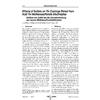Fachbücher und Fachzeitschriften
Effects of Sulfate on Tin Coatings Plated from Acid Tin Methanesulfonate Electrolytes // Einfluss von Sulfat bei der Zinnabscheidung aus sauren Methansulfonatelektrolyten
Artikelnummer: GALVANO-8059
Downloadbares Produkt
Effects of Sulfate on Tin Coatings Plate
Methanesulfonic acid (CH3SO3H, (70 % MSA)) is almost exclusivity used as the acid electrolyte in the plating of electronic components. The change from fluoboric or phenolsulfonic (PSA) acids during the past ten to fifteen years is due to ability to solubilize almost all transition metals, particularly tin and lead, yet it eliminates the hazards associated with handling fluoboric acid and the toxicity of PSA. MSA is produced by the oxidation of sulfur precursor molecules such as methylmercaptan (CH3SH), dimethlysulfate ((CH3)2SO4) or dimethyldisulfide (CH3SSCH3). During the oxidation process, side reactions may also occur producing impurities such as sulfate, chloride and nitrate and other trace organic impurities. The type of impurities and their concentrations are dependent upon the chemistry (nature of oxidant) used to produce 70 % MSA. For example, if nitric acid is used as the oxidant in the manufacture of MSA, residual nitrate may also be in the final MSA product. Post-treatment of MSA removes most if not all of the organic impurities but inorganic anions are slightly more difficult to remove. //
Methansulfonsäure (MSA) wird nahezu ausschließlich für die galvanische Abscheidung aus sauren Elektrolyten für Elektronikteile verwendet. Der Wechsel von Fluorbor- oder Phenolsulfonsäure (PSA) in den letzten 10 bis 15 Jahren ist auf die Möglichkeit zurückzuführen, die meisten Übergangsmetalle, besonders Zinn und Blei, zu lösen, so dass die im Umgang kritische Fluorborsäure und die giftige PSA eliminiert werden konnten. MSA wird durch Oxidation von schwefelhal- tigen Vorstufenmolekülen wie Methylmercaptan (DH3SH), Dimethylsulfat ((CH3)2SO4) oder Dimethyldisulfid (CH3SSCH3) hergestellt. Bei der Reaktion laufen auch Nebenreaktionen ab, die Verunreinigungen in Form von Sulfat, Chlorid, Nitrat und weiteren Spuren von organischen Verbindungen führen. Die Art der Verunreinigungen und deren Konzentrationen sind von der Art der verwendeten Chemie (Natur der Oxidation) zur Her
Methansulfonsäure (MSA) wird nahezu ausschließlich für die galvanische Abscheidung aus sauren Elektrolyten für Elektronikteile verwendet. Der Wechsel von Fluorbor- oder Phenolsulfonsäure (PSA) in den letzten 10 bis 15 Jahren ist auf die Möglichkeit zurückzuführen, die meisten Übergangsmetalle, besonders Zinn und Blei, zu lösen, so dass die im Umgang kritische Fluorborsäure und die giftige PSA eliminiert werden konnten. MSA wird durch Oxidation von schwefelhal- tigen Vorstufenmolekülen wie Methylmercaptan (DH3SH), Dimethylsulfat ((CH3)2SO4) oder Dimethyldisulfid (CH3SSCH3) hergestellt. Bei der Reaktion laufen auch Nebenreaktionen ab, die Verunreinigungen in Form von Sulfat, Chlorid, Nitrat und weiteren Spuren von organischen Verbindungen führen. Die Art der Verunreinigungen und deren Konzentrationen sind von der Art der verwendeten Chemie (Natur der Oxidation) zur Her
4,70 €
Netto-Preis: 4,39 €
Enthaltene MwSt.: 0,31 €
Shopsuche
NEU: Der Leuze Fachbuch-Finder: Dieser kleine Assistent lässt Sie in wenigen Sekunden das richtige Fachbuch finden. Probieren Sie´s aus! -> Fachbuchfinder
Weitere detaillierte Informationen zu unseren Büchern finden Sie in unserem aktuellen Verlagsprogramm 2024, welches Sie hier kostenlos als PDF herunterladen können (ca. 15 MB)









